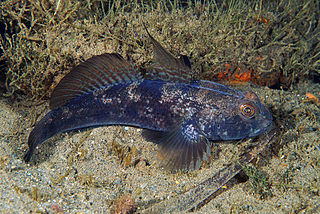
Gobiidae is a family of bony fish in the order Gobiiformes, one of the largest fish families comprising more than 2,000 species in more than 200 genera, sometimes referred to as the "true gobies". Most of them are relatively small, typically less than 10 cm (3.9 in) in length. The Gobiidae includes some of the smallest vertebrates in the world, such as Trimmatom nanus and Pandaka pygmaea, Trimmatom nanus are under 1 cm long when fully grown, then Pandaka pygmaea standard length are 9mm (0.35 in),maximum known standard length are 11 mm (0.43 in). Some large gobies can reach over 30 cm (0.98 ft) in length, but that is exceptional. Generally, they are benthic, or bottom-dwellers. Although few are important as food for humans, they are of great significance as prey species for commercially important fish such as cod, haddock, sea bass, and flatfish. Several gobiids are also of interest as aquarium fish, such as the dartfish of the genus Ptereleotris. Phylogenetic relationships of gobiids have been studied using molecular data.
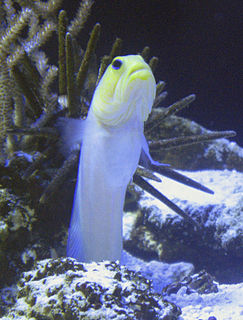
The yellowhead jawfish is a species of jawfish native to coral reefs in the Caribbean Sea. It is found at depths of from 3 to 40 metres. The head and upper body are a light, but brilliant, yellow color slowly fading to a pearlescent blue hue. It can reach a length of 10 centimetres (3.9 in) TL. Yellowhead jawfishes are usually found in Florida. They are usually found in shallow areas where materials are available for burrow construction. The Jawfishes live in rubble areas and sand in groups of up to 70 species.
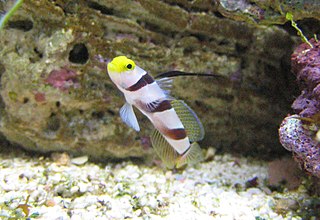
Stonogobiops nematodes, the Filament-finned prawn-goby, the Antenna goby, the high-fin goby, the red-banded goby, the high-fin red-banded goby, the striped goby, the barber-pole goby, or the black-ray Goby, is a species of marine goby native to the Indian Ocean and western Pacific Ocean from the Seychelles to the Philippines and Bali.

Nemateleotris magnifica, known by a variety of common names including fire goby, magnificent fire fish, fire dartfish, or red fire goby is a species of dartfish native to the Indian and Pacific oceans from the eastern coast of Africa to the Hawaiian Islands and from the Austral Islands north to the Ryukyu Islands. It is an inhabitant of coral reefs where it can be found at depths of from 6 to 70 metres. It is usually found just above the bottom, facing into the current, where it awaits its prey of small invertebrates.

Amblyeleotris steinitzi, Steinitz' prawn goby or simply Steinitz' goby, is a species of small fish in the family Gobiidae. It lives in association with an alpheid shrimp and is found from the Red Sea through the Indian Ocean to the western Pacific Ocean.

The sleepy goby is a species of fish in the family Gobiidae.

The Gobiiformes are an order of fish that includes the gobies and their relatives. The order, which was previously considered a suborder of Perciformes, is made up of about 2,211 species that are divided between seven families. Phylogenetic relationships of the Gobiiformes have been elucidated using molecular data. Gobiiforms are primarily small species that live in marine water, but roughly 10% of these species inhabit fresh water. This order is composed chiefly of benthic or burrowing species; like many other benthic fishes, most gobiiforms do not have a gas bladder or any other means of controlling their buoyancy in water, so they must spend most of their time on or near the bottom. Gobiiformes means "Goby-like".

Ptereleotris hanae, the blue gudgeon dartfish, blue hana goby, is a species of dartfish native to the western Pacific Ocean. It is a reef inhabitant, being found at depths of from 3 to 50 metres, though usually no shallower than 6 metres (20 ft). It inhabits burrows made by alpheid shrimp, but unlike the Amblyeleotris gobies who normally associate with these shrimp, this species has no interactions with their shrimp hosts. This species can reach a length of 12 centimetres (4.7 in) TL. It can also be found in the aquarium trade.

Fries's goby is a species of goby native to the Eastern Atlantic Ocean along the coasts of Europe and northern Africa as well as the Mediterranean Sea to the Sea of Marmara. This species burrows into muddy or muddy sand substrates at depths of from 10 to 130 metres and is frequently found in association with the Norway lobster Nephrops norvegicus. This species can reach a length of 13 centimetres (5.1 in) TL. The specific name honours the Swedish zoologist Bengt Fredrik Fries (1799-1839).

Alpheus randalli is a species of snapping shrimp in the genus Alpheus. It lives in the Marquesas Islands and parts of the Indian Ocean, including the Seychelles, in association with a goby of the genus Amblyeleotris. The shrimp is transparent or white with prominent red markings.
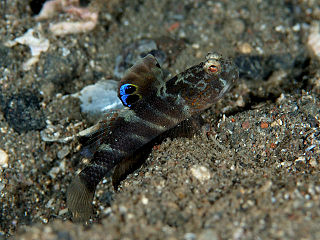
Mahidolia mystacina, the flagfin prawn goby, flagfin shrimpgoby or smiling goby, is a species of goby native to the Indian Ocean and the Pacific Ocean from Delagoa Bay, Mozambique to the Society Islands and from southern Japan to Samoa and northern Australia. This species occurs in marine and brackish waters, being found in coastal bays, estuaries and reef bases where the bottom is silty or muddy at depths of from 5 to 25 metres. This species is a commensal with a species of alpheid shrimp, using its burrow as its home. This species can reach a length of 8 centimetres (3.1 in) TL. This species can also be found in the aquarium trade. It is currently the only known member of its genus.

The grass goby is a species of goby native to the Mediterranean Sea, the Sea of Azov and the Black Sea. It is currently the only known member of its genus.

The target shrimpgoby is a species of goby native to the Indo-West-Pacific where it occurs near coasts on silty or sandy reefs at depths of from 3 to 15 metres. This species is symbiotic with alpheid shrimps. It can reach a length of 10 centimetres (3.9 in) TL. This species can also be found in the aquarium trade.
Trypauchen vagina, commonly known as the burrowing goby, is a species of eel goby found in the Indo-Pacific region. It has an elongated body about 20 to 22 cm in length. It is reddish-pink in color and possesses distinctive pouches in the upper edges of its gill covers. It lives in burrows in the silty and muddy bottoms of its marine and brackish habitats. It has reduced eyes that are entirely covered with skin and the anterior portion of its head is protected by thick flesh. Both adaptations aid it in digging its burrows.
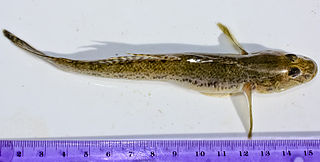
Acanthogobius flavimanus is a species of fish in the goby family known by the common name yellowfin goby. Other common names include mahaze, Japanese river goby, Oriental goby, and spotted goby. It is native to Asia, where its range includes China, Japan, Korea, parts of Russia, Vietnam, and Malaysia. It has spread beyond its native range to become an introduced, and often invasive, species. It has been recorded in Australia, Mexico, and Florida and California in the United States.

The arrow goby is a species of goby native to marine and brackish waters of the Pacific coast of North America from British Columbia to Baja California. This species grows to a length of 6.4 centimetres (2.5 in) SL, though most do not exceed 4.2 centimetres (1.7 in) TL. This fish can also be found displayed in public aquaria. This species is the only known member of its genus.

Valenciennea helsdingenii is a species of goby from the Indo-Pacific. It is commonly known as the twostripe goby, black-lined sleeper goby, or railway sleeper goby. It can grow up to a length of 25 cm (9.8 in) and is distinguishable by two prominent orange to black lines running longitudinally through its body.
Quietula is a genus of fish in the goby subfamily, Gobionellinae. There are two species, both native to the Gulf of California in Mexico. One is endemic to the Gulf, and the other also occurs along the western coast of Baja California and the coast of California. The fish were first described from Guaymas in Sonora, Mexico. The genus name Quietula is from the Latin quietus, meaning "quiet".
Alpheus tricolor is a crustacean belonging to the family of snapping shrimp. It was first isolated in Indonesia and Sri Lanka. It counts with a setose carapace, an acute rostrum, shallow adrostral furrows and a basicerite with a strong ventrolateral tooth. The lamella of its scaphocerite is not reduced, with an anterior margin that is concave. Its third maxilliped counts with an epipodial plate bearing thick setae, while its first chelipeds are found with their merus bearing a strong disto-mesial tooth; its third pereiopod has an armed ischium, with a simple and conical dactylus. Its telson is broad, distally tapering, with 2 pairs of dorsal spines. The species is named after its characteristic colour pattern, including white, red and orange.

Vanderhorstia mertensi, Mertens' shrimp goby or the slender shrimp goby, is a ray-finned fish species native to the Red Sea, Japan, Papua-New Guinea and the Great Barrier Reef. Male individuals can reach a length of 11 cm in total. In 2008 a specimen was collected in the Mediterranean Sea, in Gulf of Fethiye on the coast of southern Turkey, where it was found on sandy bottoms in the icnity of beds of sea grass such as Zostera spp., Posidonia oceanica and Cymodocea nodose in the burrows of the alpheid shrimps Alpheus glaber and Alpheus rapacida. It is thought that the gobies most likely entered the Mediterranean through the Suez Canal by Lessepsian migration from the Red Sea but the possibility of transportation in ships' ballst waters cannot be excluded. It was recorded off Israel in 2013, confirming that its origin was as a Lessepsian migrant. The specific name honours the German herpetologist Robert Mertens (1894-1975) the former director of the Naturmuseum Senckenberg in Frankfurt,who the author, Klausewitz, learnt about the biological and ecological view of modern systematics and taxonomy.


















